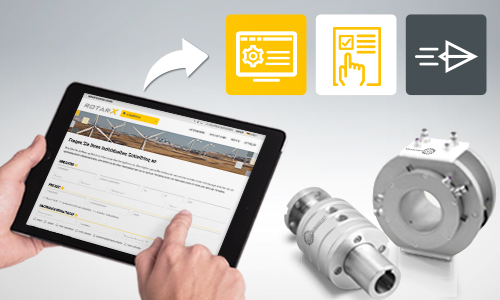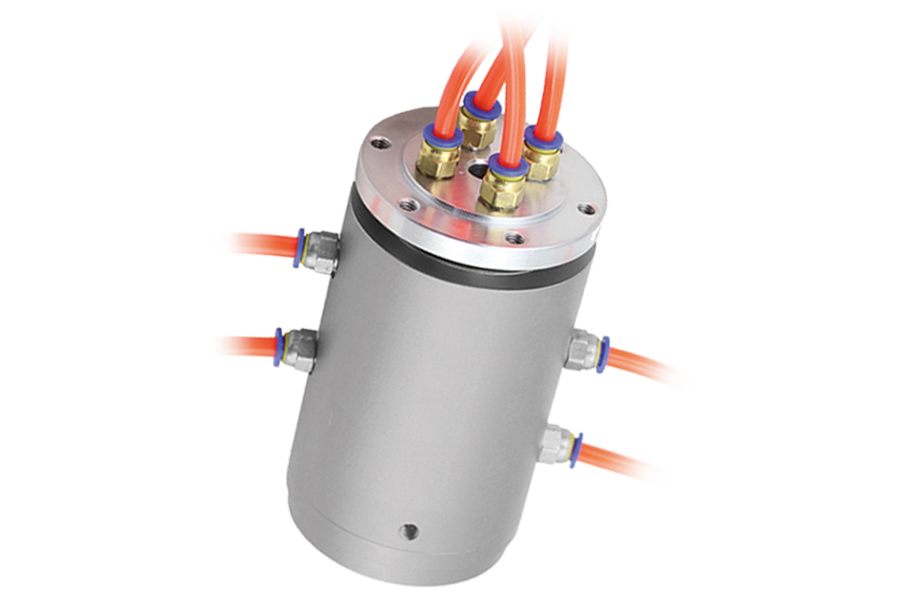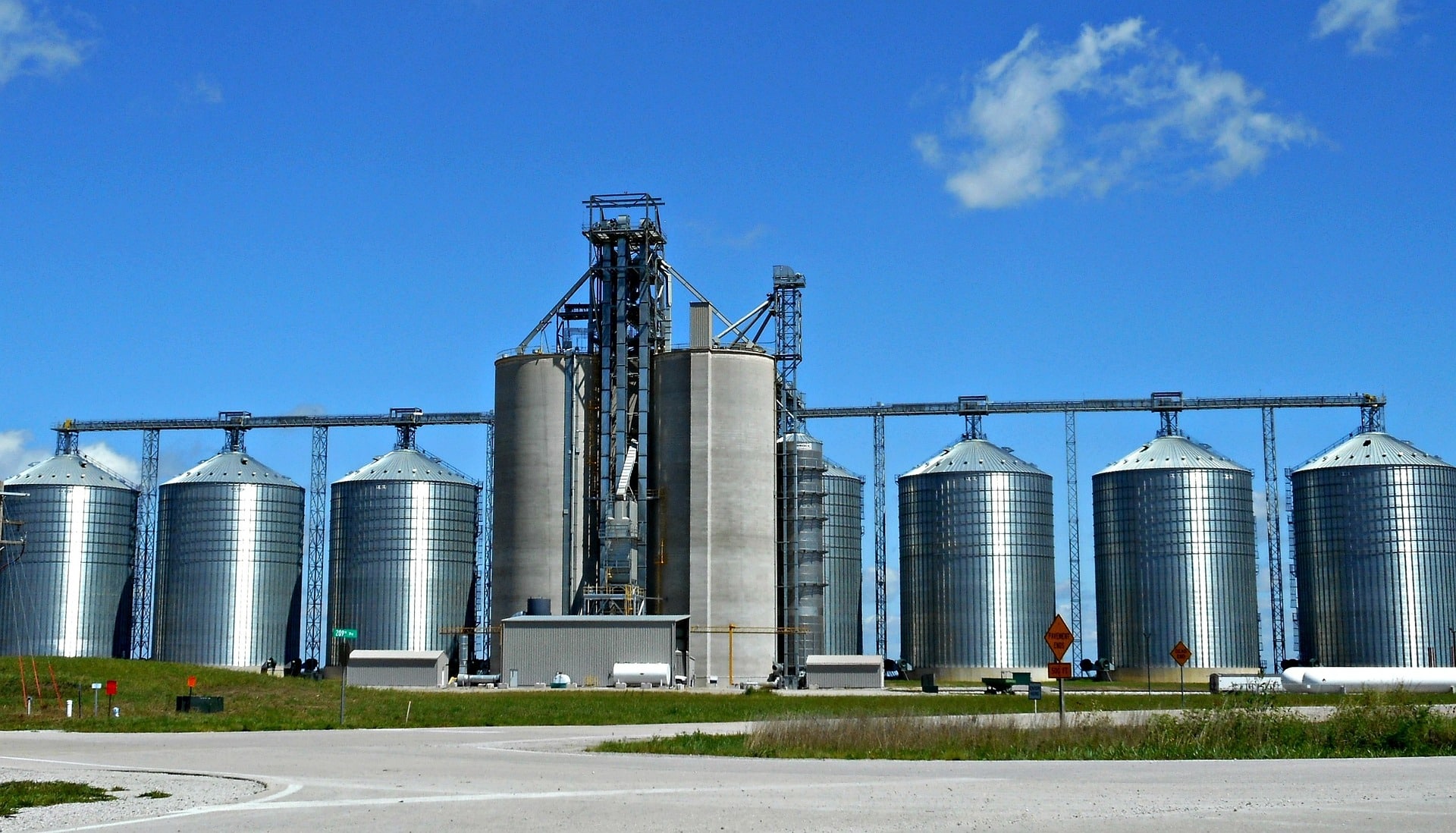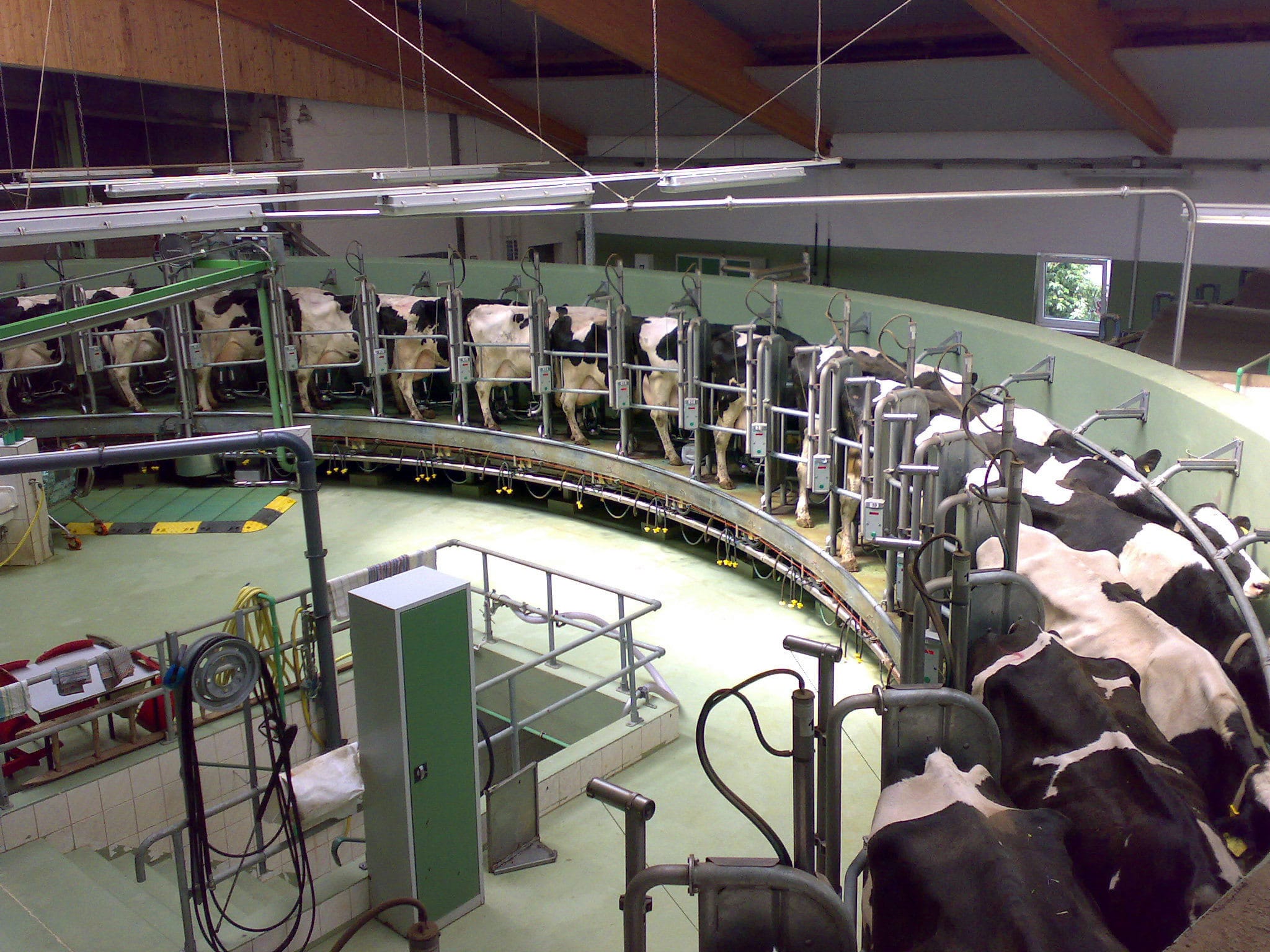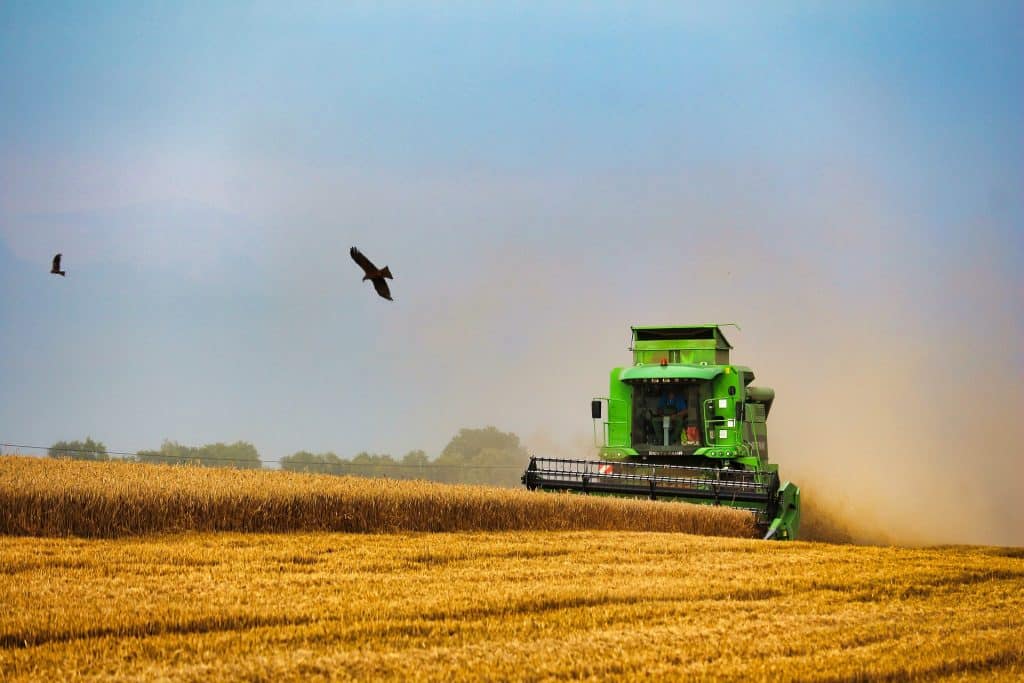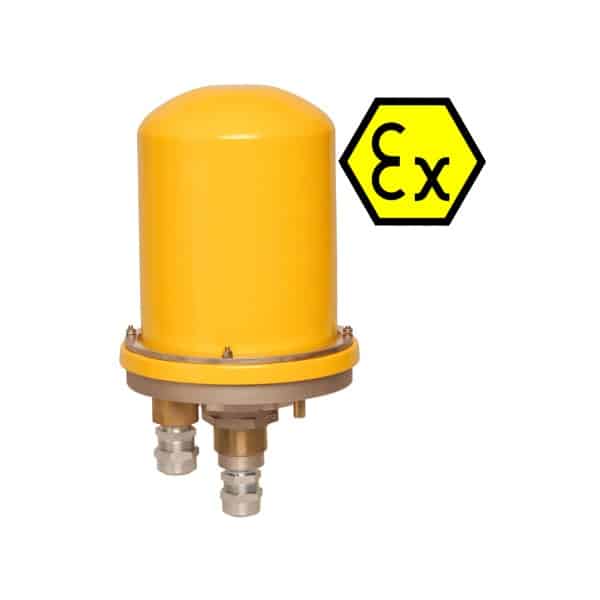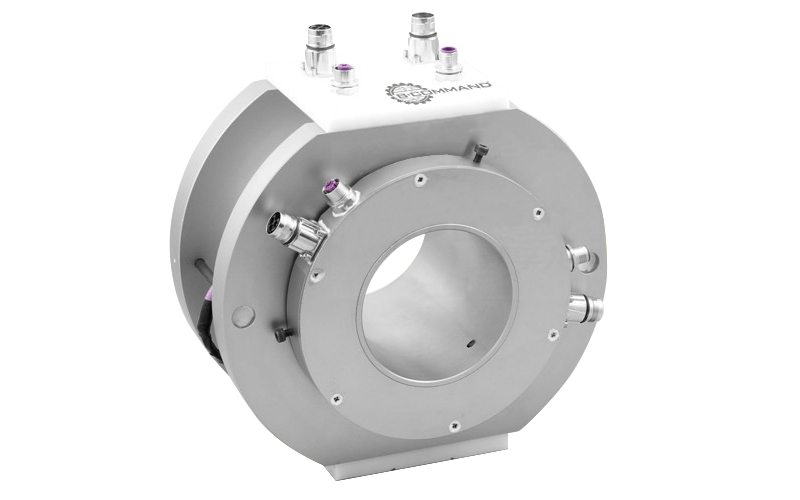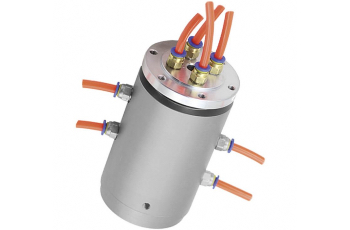
„Smart Farming“ as a synonym for Industry 4.0 in agriculture is an elementary component for improving productivity and conserving resources.
But that is far from the only challenge. Legal requirements on fuels and fertilisers also make it essential, clearly distinguish between different and new fluids and between movable and stationary components of machines and production plants in the agricultural industry. For this purpose Rotating unions which are flexible in terms of material, rotational speed (rpm) and sealing rings. Biodiesel fuel, Liquid and solid Fertiliser and Pesticides are adaptable. Multi-channel rotary unions also allow all these media to be carried out in just one component without contamination.
And there is another profound change. Smart farming requires that agricultural machinery such as combines and tractors, but also production equipment such as Milking Carousels, Hay bale wrapper or whole Silos can be connected to the internet and AI systems in order to control and optimise production processes automatically. In order to save space and costs here as well, it is crucial that rotating unions are not only able to transmit a wide variety of fluids and media, but also serve to transmit control signals, video signals, data and electricity at the same time. For example, in order to transmit weather forecasts from the mains, control signals and electricity via just one rotary union to a Pivot-Irrigation system (CPIS=center-pivot irrigation system) or another irrigation system. In this way, fertilisation and irrigation can be optimised and automated on the basis of data. Here it lends itself accordingly to Hybrid electric rotary unions be used to perform both water and fertiliser and the corresponding data, power and signals combined. And this is just one of dozens of examples of possible applications. For machines and plants that only rely on control signals and power, this offers a hybrid transmission option with various Slip rings as long as no fluids have to be transferred.
The various rotarX slip ring series are optimised for a wide range of applications. We support our customers for tailor-made solutions. All products can be individually adapted to the applications in order to offer you added value. Premium Engineering Slip Ring Solutions.Do you already know our configurator?
Challenges of agriculture in the 21st century
Agriculture and agribusiness face a number of challenges in the 21st century, including:
- Climate change: Climate change affects the growth of plants and the survivability of animals. Droughts, heat waves and storms can destroy crops and reduce farm productivity.
- Growing population: The world population continues to grow and is expected to reach about 10 billion by 2050. This will lead to an increasing demand for food, which agriculture and agribusiness will have to cope with.
- Changed eating habits: People are becoming more selective in their food choices and there is an increasing demand for healthy, sustainably produced food. This poses a challenge for farms as they have to adapt their production methods to meet these demands.
- Scarcity of resources and space: Agricultural businesses rely on resources such as water, fertiliser and energy. In some parts of the world, however, these resources are scarce and expensive, which can affect the productivity and profitability of farms. The amount of arable land needed is also becoming increasingly scarce. Currently, there are approx. 1.5 billion hectares of arable land on our planet. At 7.5 billion people the average corresponds to 2,000 square metres of arable land per person, which is also referred to as “world acreage”. Everything that feeds and nourishes humans must grow on this area. If we only ate vegetables and cereals, this area would be sufficient. But not if textile fibres, biofuel and animal food such as maize and soya are also grown on this land to supply slaughter and livestock. Today, every German citizen already needs about 2,700 square metres of arable land to reflect actual consumption patterns. 1,000 square metres are solely responsible for our meat consumption (per person 56 kilos of pork, 19 kilos of poultry, 13 kilos of beef and 1 kilo of mutton) and the accompanying arable land necessary for livestock feed. Another 340 square metres are needed for cotton alone, which is needed to produce the average 26 kilograms of clothing that every German buys per year. This leaves only 660 square metres per person of the “world acre” on which everything else must be grown: Coffee, cocoa, “energy crops” like rapeseed (z. E.g. for biofuel), Rice, vegetables, sugar and much more. So we have to change our consumption behaviour as well as gain new arable land. This calculation does not add up. According to a WWF study, if we wanted to cover our meat consumption in Germany only with domestically produced feed, we would have to use the whole of Rhineland-Palatinate for soy cultivation. Since this is not an option, we import additional arable land or feed from other countries, so to speak. This in turn affects the amount of land available for feeding people in these countries and at the same time fuels the clearing of tropical rainforests and the conversion of grassland to agricultural land. At the expense of the climate and biodiversity.
- Competition from industrialised nations: Farms in developing countries often compete with those in industrialised countries for sales markets and have to deal with much lower production costs. This can lead to an undervaluation of products and contribute to a deterioration in the living conditions of farmers in developing countries.
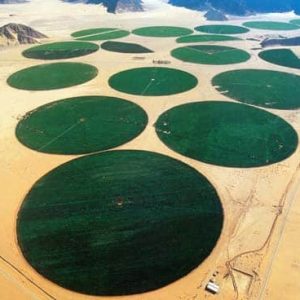
Smart Farming
Industry 4.0, also referred to as the “fourth industrial revolution”, refers to the connection of computers and the Internet of Things (IoT) to the manufacturing industry. This makes it possible to network and automate machines and plants to improve efficiency and productivity.
In agriculture, Industry 4.0 is also referred to as “Smart Farming” and involves the use of technological solutions to optimise farming operations.
Applications of Industry 4.0 in agriculture include:
- Precision Farming: This includes the use of GPS and other sensors to make farming more precise and efficient. Examples include GPS-guided machines that apply only the amounts of fertiliser and pesticides needed, and sensors that monitor crop growth and automatically adjust irrigation. By using GPS, GNNS, aerial imagery from drones and the latest generation of time-series imagery from Sentinel satellites, high-resolution maps can be created that take into account various factors such as yield, terrain characteristics, topography, humus content, soil moisture and N status.
- Data analysis: The use of Big Data and artificial intelligence (AI) can help optimise agricultural decisions and automate processes. Examples include weather forecasts that optimise irrigation and fertilisation, and AI systems that help with crop selection and crossing.
- IoT in agriculture: Connecting agricultural machinery and equipment to the internet allows them to be monitored and controlled remotely. This can help minimise downtime and improve efficiency.
- Smart Building & Farm Management: »Smart Building« refers to buildings equipped with technologies such as the Internet of Things (IoT), artificial intelligence (AI) and automated systems to optimise their functionality and efficiency. In the context of farm management, for example, smart building could involve the use of IoT sensors and AI systems to monitor and control farm buildings. For example, monitoring temperatures and humidity levels in livestock buildings and silos to improve the health and well-being of livestock, or Grain bins with more than 2,000 bushels of grain (1 bushel is 27.2155 kilograms) automated and data-controlled cooling. This is necessary because the temperature in grain bins can exceed 480 degrees Celsius. Problems with the high temperatures occur when moist air drops along the outer surface of a bin and warm air rises in the centre, which can cause convection. Using aeration to cool grains and remove moisture helps to maintain grain quality and prevent pests from entering.
The introduction of Industry 4.0 in agriculture can help increase farm productivity and profitability, but there are also concerns about potential impacts on jobs and the sustainability of agriculture.
What is certain, however, is that for all these applications slip rings and rotary unions are needed that not only fulfil their traditional tasks such as current and power transmission and media feed-through, but can also transmit a wide variety of signals and data.
Hybrid pneumatic/liquid + electric
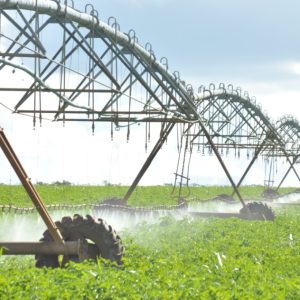
Smart Farming Examples
There are a number of potential applications for slip rings and rotating unions in agriculture, including axles, lines, motors and hydraulic systems. The aim here is always to further Automation of harvesting and manufacturing processes in agriculture and the agricultural industry. And the longevity of the individual components. This is the only way to save resources in the long term, to open up new arable land and to reduce the consumption of water, pesticides and fertilisers.
To further automate the harvesting process, it is necessary for the machines to be able to carry out the harvesting independently. This requires taking into account soil conditions, plant conditions and weather conditions, which affect the settings of the control signals and parameters of the harvesting machines. Sensors must measure the moisture and fertiliser content of the soil, among other things, or determine which plants are already ripe for harvesting. The consideration of differences in the soil and the yield capacity within a field in harvesting technology is called “precision farming”. The goal in smart farming is for machines to carry out this precision farming independently.
This means that, on the one hand, the machines must have all the information about the field, know their own position and accordingly know which settings are required. On the other hand, they must also be able to react to special features such as obstacles, for example animals in the field. The implementation of these requirements requires a lot of background information, which can only be obtained through long-term generated and collected data and learning processes. (AI and Big Data) can be obtained.
In addition, not only the sensors must be able to collect data and transmit it to the cloud. Another basic requirement is the Communication capability of the harvesting machines and vehicles used. In order for these to act autonomously, the data collected by the sensors must be able to be converted into control signals and transmitted to the machines. In addition to the media that are necessary anyway, such as hydraulic oil, water, fertiliser or pesticides. Likewise, the devices must be able to independently transmit error messages in real time to a management system and be monitored and evaluated remotely. A connection to the internet (IoT) is therefore elementary anyway. In addition, the machines must be able to communicate with each other in order to navigate and coordinate.
Central pivot irrigation systems
An example of this is the use in central irrigation systems. The so-called CIPS (Centre Pivot Irrigation Systems) are very popular in the field due to their efficiency, uniformity and versatility. The sprinkler rotates around a central axis on which a slip ring is mounted to transmit power and allow rotation around the central axis.
The history of CPIS began in Nebraska in 1950. In the meantime, they are in use worldwide and probably the most important mechanical invention in agriculture since the replacement of oxen by tractors.
The irrigation system moves across the field with electrically activated wheels, while the Flow velocities increase in the direction of the ends of the pivot, as these rotate faster than the inner parts. The primary design limitation of this system is to prevent overflow at the swing connections where flow rates are very high.
In Smart Farming, this could now be supplemented by Ethernet Slip Rings or Glass fibre slip rings can be installed to transmit collected data from the soil sensors to the irrigation system and thus adjust the amount of water or fertiliser to the soil conditions, plants and also the weather. At the same time, the irrigation system can transmit any error messages or fill levels. In addition, sensors in the tyres could check and transmit the tyre pressure and, if necessary, adjust the air pressure to changing soil conditions (tyre pressure control system).
Hybrid rotating unions would offer the additional advantage that they could not only transfer power and energy between stationary and rotating components of the irrigation system, but also the required fluid, i.e. water, pesticides, herbicides or fertiliser.
It is crucial that there are no miscalculations. The sensors must therefore function reliably and no data packets must be lost on the way to the irrigation system.
This is the only way to increase efficiency in the use of plant protection products and fertilisers in order to Costs savings. In addition, this helps farmers to reduce the Fertiliser Ordinance to comply with. In addition, precision farming has positive effects on the environment, as the Nitrate contamination in the soil decreases and surrounding wild plants and insects are spared. Conversely, of course, this also means that incorrect calculations can lead to overfertilisation. Ultimately, this favours crop failures and enormous consequences for the environment.
And also GPS-Systems can assist with fertilising, for example when no CPIS is used, but fertiliser and water are spread classically with a tractor. The tractor’s position in the field, which is recorded via a GPS system and satellite images, can be used to prevent fertiliser from being applied outside the field. The precisely recorded driving radius also avoids double fertilisation, which is otherwise associated with large costs and declining efficiency.
If the corresponding agricultural machines drive autonomously in the future, then low precision will be accompanied by all the greater losses. If, for example, the combine harvester drives too far over the Cut edge, a strip of the field must be travelled twice. If this error is repeated several times because the work cannot be monitored via drones, sensors and satellite images and subsequently corrected via remote control and/or the combine does not send correct position data and error messages, this is accompanied by all the more serious problems. Sales losses associated. To solve this problem, local antennas are used that transmit correction signals with an accuracy of two centimetres. And here again, the corresponding data must be converted into control signals for autonomously driving machines and transmitted via slip rings or rotary unions.
Slip rings Hotspots
Hybrid Glass fibre slip rings for the transmission of analogue or digital optical signals with Data rates up to 10 GBit. Singlemode or multimode fibres for single or multi-channel transmission. Customised and combined power and signal versions possible.
Silos
Another common application for slip rings in agriculture are grain silos. These preserve and store grain or silage for later use. Although they are relatively simple structures that require few if any high-tech systems, they still need to be carefully installed, operated and maintained. From filling and monitoring, to unloading the silo, slip rings play an essential role. A special requirement is the Explosion protection. There can be a lot of explosive dust inside the silos, which can easily lead to an explosion. Therefore, we offer explosion-proof slip rings that are suitable for these applications. IECEx and ATEX certified are.
For unloading a grain or cattle feed bin, the grains flow out from the top via an outlet in the middle of the lower part. A screw conveyor is installed at the outlet to transport the grains into a transport vehicle or other container.
The outflow of the large mass of grains creates a hydraulic gradient that takes on the shape of a funnel at the upper end of the container. People who are at this point when unloading a silo can be drawn into the process by the flow pressure. In the worst case, this can even lead to death.
Slip rings are installed in the required equipment both for the operation of the augers and for the possible video monitoring of the risky areas during unloading.
Since temperatures of more than 400 degrees Celsius can also be generated in a loaded silo, a Cooling system necessary. Especially when over 2.000 Bushel be stored in a silo. A bushel of wheat (US bushel wheat) corresponds, by the way, to approx. 27 Kilogram. Rotary unions and slip rings are also often needed for such a cooling system.
Milking carousel
Automatic milking processes usually work without people monitoring the process or connecting the milking equipment to the teats. Feeding and milking robots not only offer great cost savings and efficiency gains, but they also document their process data and transmit it to the cloud. Robots can accurately document data on the amount of feed, the health condition of the animals or the amount of milk delivered, and farmers can monitor this continuously via computer or smartphone. In the cloud, neural networks and machine learning can then identify correlations between health status, feed and quantity of milk delivered that humans would never recognise so quickly (or not at all).
Slip rings play an important role especially in rotating milking parlours. These are similar in design to a carousel in which the cows move around a central axis during milking and can return to their feeding and resting caves after milking. These rotating dairy barns are also called Milking carousel designated. The equipment moves quite slowly so that the cows can enter and exit the structure at constant intervals.
They enter the rotary milking parlour for milking and are later returned to their feeding or resting places. Of course, cows can also be milked in the classic rectangular stalls of a dairy barn by having staff attach milking machines to the teats, which transport the milk via a pipe milking system.
The main advantages of rotary milking parlours compared to manual milking of animals are the improvement of work efficiency, ergonomic benefits and minimisation of the risk of damage due to tipping over and repetitive stress.
In a rotary milking parlour, the highest efficiency is achieved when the farmer’s routine work schedule is (mainly consisting of the time required to attach a milking machine) and the speed of the unit are closely linked.
In a rotary milking parlour, unlike a herringbone parlour, most tasks are automated; therefore, attaching the cluster is the most important task, apart from reattaching the pipes, regulating the rear inlet or idle time when the machine is running slowly.
A shorter duration of routine work increases the number of animals that can be cared for. The throughput (highest number of animals that can be milked in one hour) is estimated by 3600 (the number of seconds within one hour) is divided by the duration of the routine work.
But for maximum productivity, many factors outside the carousel must be kept constant. The animals must be clean before they enter the rotating structure.
In addition, the cows’ transport routes to the milking carousel must be designed in such a way that humans disturb them only minimally, and the distances within the milking carousel must also be reasonable.
Whether the farmer’s goals are animal comfort or simplicity of operations, rotary barns can play an important role in farming. The animals enjoy comfortable and quiet rounds at a reasonable speed, which translates directly into high productivity.
Compared to other milking systems, milking carousels can handle the milking process faster and achieve higher yields with the right routines, reliability and protocols.
But whenever something turns, slip rings and rotating unions are also necessary to transmit power, media and signals. In rotary milking parlours, the milk must first be fed through rotary unions, while at the same time water must be moved for cleaning the stalls and animals. In addition, the installed slip rings and rotary unions could also transmit data on the rotation speed of the rotary milking parlour, but also on the degree of soiling of the animals or the fill level of the milk containers.
Dynamic tyre pressure control is a basic requirement for modern agricultural and construction vehicles
Mobile agricultural machinery in particular – first and foremost the Tractor or combine harvester – drive on a variety of different surfaces. However, this also applies to some extent to construction vehicles. In agriculture, a tractor may have to drive both over and under a Sand, clay soil, asphalt, field, meadow and forest soil drive. At the same time, the machines are becoming heavier and heavier and the trailers hold ever greater volumes. Therefore, it is a basic requirement for modern machines that the tyre pressure can be dynamically controlled during operation and adapted to the ground in order to extend the service life of the tyres and also protect the ground at the same time. If the tyre pressure cannot be adjusted, the Safety and durability requirements of the tyres, and the Requirement to protect roads, farmland and forest soil are almost irreconcilable.
Thus a High tyre pressure on the road This is for a longer service life of the tyre and more safety when steering and braking. On the Field, or on soft soils such as forest floor or meadows, but it favours the so-called “pest”. Bulldozing-Effect, thus a large spurt depth and the associated high fuel consumption. A low tyre pressure would increase the tyre contact area here and counteract the bulldozing effect.
In addition, high tyre pressure leads to more compaction on soft soil and thus worsens the following crop, while at the same time making it more difficult for rainwater to seep away, which increases the risk of soil erosion and flooding. Dynamic tyre pressure control during operation allows the tyre pressure to be increased accordingly on the road and decreased on soft soil. Rule of thumb: 0.5 bar to 1.2 bar in the field, on the road about 2 bar to 2.5 bar.
But in everyday operation, the farm changes between field work and transport so frequently that manually adjusting the air pressure at each change is very labour-intensive. This is where the dynamic tyre pressure control system comes into play. It must be possible to adjust the air pressure at the push of a button via the control system in the driver’s cab – during operation, while the tyres are rotating. This makes multi-flow pneumatic rotary unions necessary, both for Single-circuit as well as dual-circuit systems. TheInterface between compressed air supply and rotating tyre is always the rotary feed. It takes the compressed air from the compressor (stator side) and guides it through the rotor into the tyres. Combined electrical rotary feed-throughs also make it possible to transmit the measured values to the driver’s cab in order to display the current tyre pressure. This saves an additional electrical slip ring.
Incidentally, this function can also be retrofitted to older agricultural machines, for which the rotating union is mounted on the front edge of the axle hub. Compact rotating unions such as those from rotarX also make it possible to install the rotating unions inside the axle (in-axle designs). Only the connection thread is then visible from the outside.
Video signals & sensors
An elementary component, especially for precision farming with the aid of autonomous agricultural machinery, are numerous sensors and video signals.
Only they make the so-called “site-specific cultivation” of fields possible. This is one of the most promising approaches for more sustainable and efficient agriculture. Due to uneven soil conditions, primarily large fields, small-scale management makes much more sense than uniform tillage.
For this purpose, data on soil, plants, water supply and the agricultural machinery used are collected and linked to GPS positions of tractors and combine harvesters, which enables more targeted sowing, fertilisation and irrigation.
In the future, a fully automated process could look like this, for example: Robots first sow the seeds and document the exact position of each plant via GPS data. Drones can monitor growth and detect weeds, while harvesting robots use image and sensor data to detect whether fruits and vegetables are ready for harvesting. The latter already works today, by the way. If they are ripe, the harvesting robots can go into action and bring in the yields. Then, with the help of modular containers that are adapted to the harvested quantity, logistics robots can bring the harvest to weight and quality control, pass it on to packaging machines and laser seal the packages.
However, optical sensors and especially video signals reach their limits here at some point.
For example, must tall plants such as maize, wheat or rape seed harvested, there is a great danger to people and animals in the field that could not be detected by the sensors. In addition to optical sensors, infrared, microwave and heat sensors are therefore also important.
And monitoring the floors also requires more than optical sensors or video cameras.
Sensors under the surface of the field have to measure the moisture and temperature of the soil, for example, and then send it to the cloud. There, farmers can then retrieve them via app or computer. However, via antennas and the mobile phone connection, they can also be sent directly to the farm’s computers, where they then specifically influence the irrigation and fertilisation of plants. Nitrogen sensors can also detect the colour of plants’ leaves via light waves and provide an accurate fertilisation recommendation, which can be communicated directly to a tractor’s on-board computer, for example.
But no matter how smart the ideas, the technology and the concepts already are today. All of this only works if the individual components, such as the wheels and the harvesting attachment of a combine harvester, be able to react flexibly to the data by sending and receiving control signals and data. And for this it needs Smart, robust and low-maintenance slip rings and rotary unions, which transport the data from the cloud and the IoT directly into the machine control.
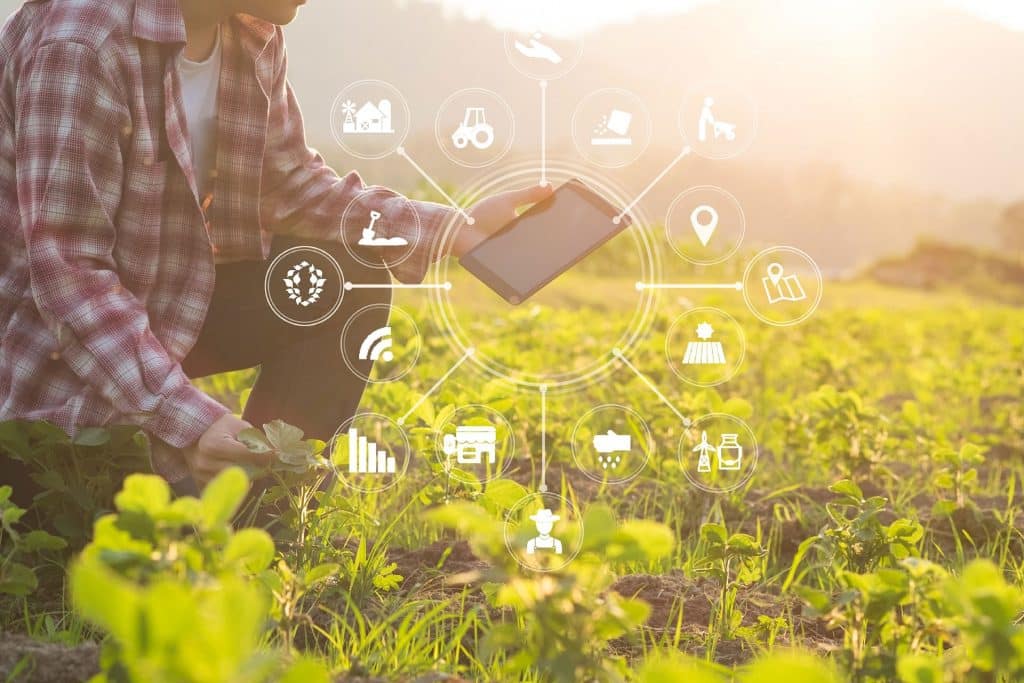
ATEX certified slip rings
The Slip ring EXD has been specially developed for use in silos and is approved for both zone 21 and zone 22. Zone 21 is a place in which an explosive atmosphere in the form of a cloud of combustible dust in air is likely to occur in normal operation occasionally. Zone 22 is a place in which an explosive atmosphere in the form of a cloud of combustible dust in air is not likely to occur in normal operation. If it does occur, it will only last for a short time. For this solution, we can also add an optional anti-condensation heater to prevent the formation of condensation to avoid corrosion.
Slip rings with hollow shaft
Hollow shaft slip rings are a good choice for applications where space is limited. This slip ring has a rotating profile with an open inside. These hollow shafts are suitable as empty tubes for mounting on an axle or for passing cables through. It is also common to use the hollow shafts for passing gases or liquids, as is common in hydraulics, pneumatics and media lines. In addition, the hollow shaft slip rings are fully rotatable, ensuring continuous rotation without having to worry about leakage. We offer a variety of different sizes and configurations to ensure we have a solution for your needs.
Enclosed slip rings
The encapsulated slip rings are one of our most versatile slip ring solutions. These are available in a variety of sizes, configurations and materials to ensure they can withstand the rigours of farming. Attached to the rotor are a series of contact rings that are insulated from each other. To the inside, the contact rings are connected with an insulated cable that is led out of the slip ring to the front. Signal cables that end in sliding contacts also lead into the stator part. Incoming and outgoing cables always have the same colours, so that confusion-free assignment during installation is guaranteed. As these slip rings are encapsulated, the rings are protected from their environment, including penetrating dust or moisture and vibrations. This ensures a longer and lower maintenance life of the slip ring.
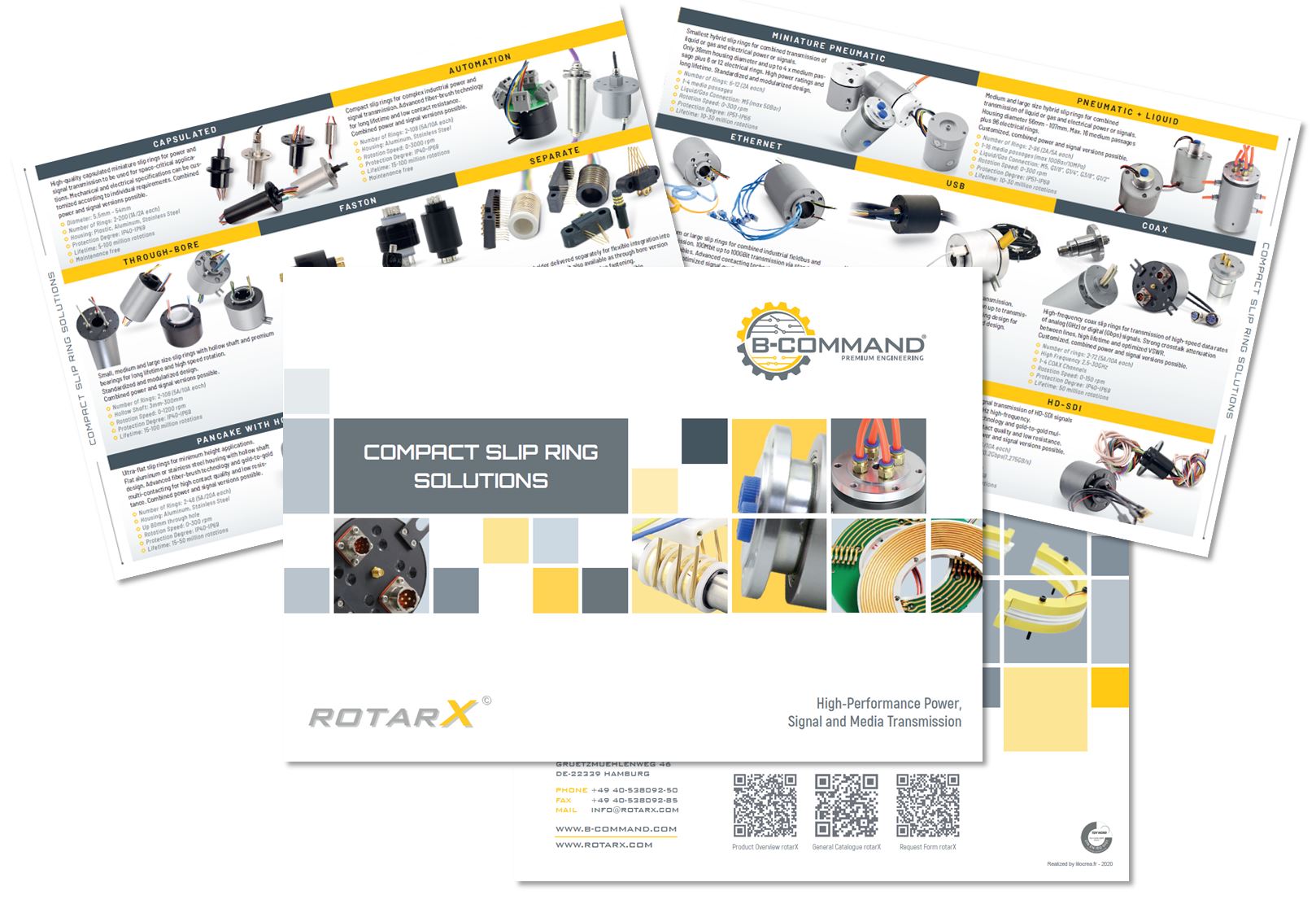
Product catalogue for all slip rings
Find out about the different slip rings in our current overview. Transmission technology for complex industrial and safety-relevant applications form the core of our product range. All products can be individually adapted to the applications in order to offer you added value. Premium engineering - that is our claim for every single product we manufacture. We would like to convince you of this.
Practical slip ring solutions for your application
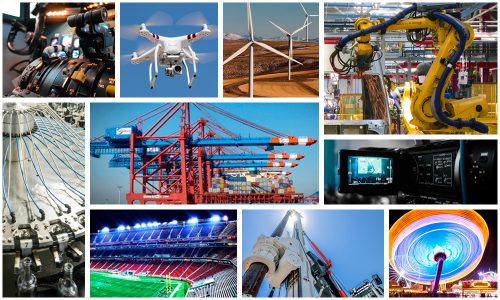
Do you have questions or would you like advice?
You can reach us Mon - Fri from 8 am to 5 pm.














